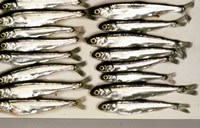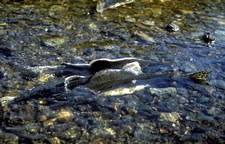
 Injury
Injury
Up to 75 percent of wild pink salmon in Prince William Sound spawn in the intertidal portions of streams. Eggs deposited in gravel and developing embryos were chronically exposed to hydrocarbon contamination from the water column and from leaching oil deposits on adjacent beaches. When juvenile pink salmon migrate to saltwater, they spend several weeks foraging for food in nearshore habitats. Thus, juvenile salmon entering seawater from both wild and hatchery sources were likely exposed to oil as they swam through contaminated waters and fed along oiled beaches. Two primary types of injury impacted early life stages of pink salmon: 1) growth rates in both wild and hatchery-reared juvenile pink salmon from oiled parts of the Sound were reduced; and 2) increased embryo mortality was documented in oiled versus unoiled streams.
Recovery Objective Pink salmon will have recovered when population indicators, such as juvenile growth and survival, are within normal bounds and when ongoing oil exposure, which may cause injury to pink salmon embryos (eggs), is negligible.
Recovery Status
In the years preceding the spill, returns of wild pink salmon in Prince William Sound varied from a maximum of 23.5 million fish in 1984 to a minimum of 2.1 million in 1988. Many factors, such as the timing of spring plankton blooms and changes in water circulation patterns throughout the Gulf of Alaska are likely to have a great influence on year-to-year returns in both wild and hatchery stocks of pink salmon. Since the spill, returns of wild pinks have varied from a high of about 12.7 million fish in 1990 to a low of about 1.9 million in 1992. In 2001 the return of wild stock fish was estimated to be 6.7 million fish.
The decade preceding the oil spill was a time of peak productivity for pink salmon in the Sound. In 1991 and 1992, it appears that wild adult pink salmon returns to the Sound's Southwest District were reduced by 11 percent; however, wild salmon returns are naturally highly variable. Furthermore, the methods used to estimate this decrease could not be used to produce reliable injury estimates across multiple generations of salmon. An analysis of escapement data from 1968-2001 did not show any differences in annual escapements between oiled and unoiled parts of the Sound. Therefore, population-level effects from the spill did not impact wild pink salmon or were short-lived.
 Sound-wide population levels appear to be within normal bounds. In addition, reduced juvenile growth rates in Prince William Sound occurred only in the 1989 season. Since then, juvenile growth rates have been within normal bounds.
Sound-wide population levels appear to be within normal bounds. In addition, reduced juvenile growth rates in Prince William Sound occurred only in the 1989 season. Since then, juvenile growth rates have been within normal bounds.
Higher embryo mortality persisted in oiled streams when compared to unoiled streams through 1993: These differences were not detected from 1994-1996, but higher embryo mortality was again reported in 1997. It could not be determined if the reemergence of elevated embryo deaths was due to the effects of lingering oil (perhaps newly exposed by storm-related disturbance of adjacent beaches), or due to other natural factors (e.g., differences in the physical environment). Although patches of lingering oil still persist in or near intertidal spawning habitats in a few of the streams used by pink salmon in southwestern Prince William Sound, the amounts were considered negligible based on 1999 and 2001 studies. In 1999, dissolved oil was measured in six pink salmon streams that had been oiled in 1989. Only one of the six streams had detectable concentrations of oil, and they were about a thousand times lower than concentrations reported as toxic to developing pink salmon embryos.
Based on these results, continuing exposure of pink salmon embryos to lingering oil is negligible and unlikely to limit pink salmon populations. Given the fact that pink salmon population levels and indicators such as juvenile growth and survival are within normal bounds, pink salmon were considered RECOVERED from the effects of the oil spill in 1999.
Click HERE for more information on Trustee Council funded studies of pink salmon.
